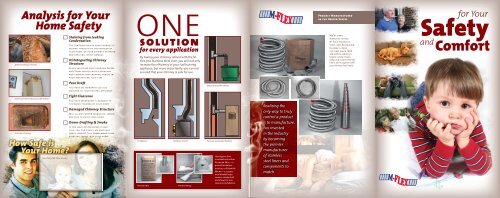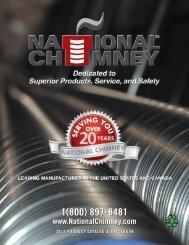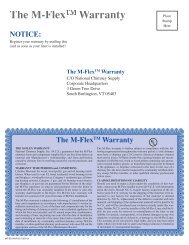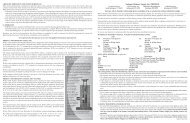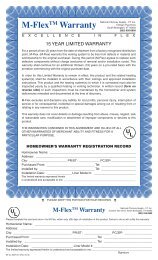Comfort - National Chimney
Comfort - National Chimney
Comfort - National Chimney
You also want an ePaper? Increase the reach of your titles
YUMPU automatically turns print PDFs into web optimized ePapers that Google loves.
Analysis for Your<br />
Home Safety<br />
Deteriorating <strong>Chimney</strong><br />
Staining from Leaking<br />
Condensation<br />
The condensation in your chimney is<br />
seeping through to the interior of<br />
your home, or your chimney exterior,<br />
and creating costly damage<br />
Disintegrating <strong>Chimney</strong><br />
Structure<br />
Acidic moisture goes through Freeze<br />
and Thaw periods with expansion<br />
and contraction creating cracks in<br />
your mortar and flue tiles<br />
one<br />
solution<br />
for every application<br />
By having your chimney relined with the M-<br />
Flex 316L Stainless Steel Liner, you will not only<br />
increase the efficiency of your fuel burning<br />
appliance, but more importantly, you can rest<br />
assured that your chimney is safe for use.<br />
Proudly Manufactured<br />
in the United States<br />
We’ve been<br />
manufacturing<br />
M-Flex Stainless<br />
Steel and Aluminum<br />
<strong>Chimney</strong> liner<br />
systems since 1992<br />
and with the industry’s<br />
largest variety of sizes,<br />
alloys and custom chimney<br />
liners, we’re eager to fulfill<br />
your chimney liner needs.<br />
for Your<br />
Safety<br />
and<br />
<strong>Comfort</strong><br />
Poor Draft<br />
You have an improper flue size<br />
matched to your heating appliance<br />
Wood and pellet stoves<br />
Staining from Leaking Condensation<br />
Unlined <strong>Chimney</strong><br />
How Safe is<br />
Your Home?<br />
Tight Clearance<br />
You have inadequate clearance to<br />
the wood framing of your home<br />
Damaged <strong>Chimney</strong> Structure<br />
Will allow carbon monoxide, smoke,<br />
and fire to enter your home<br />
Down-Drafting & Smoke<br />
If you have an improperly lined<br />
flue, you can expect an unsteady<br />
draft leading to a down-ward flow<br />
bringing smoke into your home<br />
Fireplaces<br />
Premier Mix<br />
Fireplace inserts<br />
Premier Wrap<br />
Furnace and water heaters<br />
Having your liner<br />
insulated with either<br />
Premier Mix — a<br />
poured insulation<br />
mixture, or Premier<br />
Wrap — a ceramic<br />
wool blanket helps<br />
create a steady draft<br />
and allows for zero<br />
clearance installation.<br />
Realizing the<br />
only way to truly<br />
control a product<br />
is to manufacture,<br />
has invested<br />
in the industry<br />
by becoming<br />
the premier<br />
manufacturer<br />
of stainless<br />
steel liners and<br />
components to<br />
match.
Why reline a<br />
chimney flue<br />
— especially when<br />
it looks fine?<br />
The interior is often<br />
dramatically<br />
different and in need<br />
of attention<br />
Don’t let damage<br />
& deterioration<br />
lead to hazardous<br />
conditions<br />
your perfect<br />
solution<br />
M-Flex<br />
cb 316l/Ti Titanium<br />
The Professionals Choice for<br />
Superior Venting Efficiency<br />
The flue liner is often the<br />
most neglected part of<br />
your chimney. Traditional<br />
masonry flue tiles cannot<br />
handle the acidic moisture<br />
created by your furnace,<br />
boiler, or hot water tank.<br />
This acid attacks and<br />
breaks down flue tiles and<br />
the mortar in between<br />
them. This damage can<br />
prevent harmful exhaust<br />
gases from leaving your<br />
chimney and home.<br />
Oil Heating Appliances<br />
When mixed with acidic condensation,<br />
soot buildup from your oil<br />
furnace and hot water tank on the<br />
walls of the chimney create sulfuric<br />
acid, which will deteriorate the clay<br />
flue tiles.<br />
Gas Heating Appliances<br />
Greater amounts of condensation<br />
produced by the high efficiency<br />
of newer heating appliances,<br />
combined with many installations<br />
in old oil furnace flues, speeds up<br />
deterioration. 2 cubic feet of water<br />
vapor is produced with each 1 cubic<br />
foot of gas burned.<br />
Fireplaces and Wood Stoves<br />
Creosote formation is the<br />
unavoidable by product from<br />
burning wood. Most wood stoves<br />
are manufactured to vent into an<br />
area much smaller than that of<br />
your chimney flue. The oversized<br />
flue causes a reduced rate of smoke<br />
exiting the flue, leaving it to linger<br />
and deposit creosote on your tiles.<br />
The danger with creosote is the<br />
450˚f ignition point — consider the<br />
average wood stove produces gases<br />
leaving your fireplace at 300˚f to<br />
900˚f— causing a chimney fire of<br />
up to 2100˚f. If your chimney flue<br />
has no tiles, it is likely that these<br />
gases and creosote are leaking<br />
directly into your home, leading to<br />
a possible fire or creating carbon<br />
monoxide poisoning.<br />
Real Statistics<br />
In 2001, an estimated 18,300<br />
reported home structure<br />
fires involving chimneys<br />
supporting solid-fueled<br />
equipment resulted in $48<br />
million in direct property<br />
damage. (NFPA)<br />
<strong>Chimney</strong> defects can result<br />
in injury or death from<br />
fire and carbon monoxide<br />
poisoning.<br />
Having a fire start in your chimney<br />
and rising to 2100˚ is extremely<br />
damaging and dangerous to your<br />
family. It doesn’t take a lot to start<br />
a house fire once your chimney has<br />
reached the threatening point of<br />
catching fire. One spark through<br />
a crack or an ember igniting<br />
the creosote and climbing your<br />
chimney seeking an escape route is<br />
often enough.<br />
No fireplace? Your furnace flue<br />
is responsible for venting deadly<br />
gases which can escape into your<br />
home through the tiniest of cracks.<br />
Real Statistics<br />
In 2001, 656 people died<br />
of unintentional non-fire<br />
exposure to gases... and there<br />
have been more than 30,000<br />
hospital emergency room<br />
injuries per year. (NFPA)<br />
Why wait to prevent something<br />
so dangerous to your family?<br />
The M-Flex Liner is air<br />
and water tight, locking<br />
in moisture and hazardous<br />
gases — exhausting them<br />
safely out of your home!<br />
The M-Flex cb Stainless Steel<br />
Flexible <strong>Chimney</strong> Liner is designed to<br />
reline existing chimneys or to be used<br />
as a liner in new construction.<br />
The M-Flex Liner alloys<br />
are designed specifically<br />
to resist acids and extreme<br />
temperature stress during hot<br />
and cold cycles.<br />
The M-Flex Liner is manufactured<br />
with a double overlap, crimped seam<br />
that leaves the product with an<br />
extremely strong finish and unequaled<br />
flexibility. Using the highest quality,<br />
Prime Mill Certified 316l grade alloy<br />
steel available today, the M-Flex<br />
Liner has an extremely high acid<br />
fighting capacity, with excellent heat<br />
resistance. Also, since no heat is used<br />
during manufacturing, such as welded<br />
seam products, there will be no loss in<br />
corrosion resistance that may be caused<br />
by direct heating of the stainless steel.<br />
Safety Tip<br />
The <strong>National</strong> Fire<br />
Protection Association<br />
(in nfpa 211) says,<br />
“<strong>Chimney</strong>s, fireplaces, and<br />
vents shall be inspected<br />
at least once a year for<br />
soundness, freedom from<br />
deposits, and correct<br />
clearances. Cleaning,<br />
maintenance, and repairs<br />
shall be done if necessary.”<br />
Fully tested and listed by<br />
Underwriters Laboratories to UL<br />
1777 and UL 441 for wood, pellet,<br />
oil, gas, and coal.<br />
The M-Flex cb Stainless Steel<br />
Flexible <strong>Chimney</strong> Liner is backed by a<br />
limited Lifetime Warranty.


